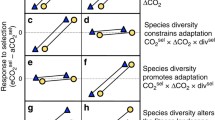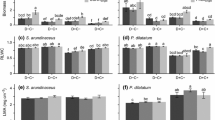Abstract
The ability of species to tolerate a warming climate has important implications for ecological functioning. Theory and empirical synthesis suggest species adapted to more thermally variable climates are more capable of acclimating to rising temperatures, and are therefore characterized by greater phenotypic plasticity, than species adapted to less thermally variable environments. But this pattern has not been extensively evaluated for populations within a species that may inhabit different parts of a thermal gradient. In addition, it remains unclear whether different populations with different thermal sensitivities will maintain the same functional ecological roles as thermal regimes shift. To address this question, we conducted a reciprocal transplant experiment using Melanoplus femurrubrum grasshopper populations from Connecticut and Vermont, USA. During summer, the Vermont site was 3 °C cooler on average with 1.5-fold greater temperature variation than the Connecticut site. We measured thermal sensitivity (metabolic rate Q10) of individuals from each population reared in home field and transplanted sites and the nature and strength of trophic interactions with grasses and goldenrod (Solidago). Both grasshopper populations exhibited plasticity, but Q10 of both populations at Vermont was 1.5-fold broader than populations at the Connecticut site. All grasshoppers had similar survivorship but not similar effects on plants, exhibiting stronger effects on grasses in their home fields relative to their transplanted sites. Only Vermont grasshoppers transplanted to Connecticut significantly impacted Solidago. The study shows populations may physiologically acclimate quickly under new thermal conditions, suggesting stronger tolerance to change than often presumed. But, thermal acclimatization may not translate into the maintenance of a species’ functional role. The work underscores the need to link analyses of physiological performance with ecological function to obtain a complete picture of climate change effects on communities.





Similar content being viewed by others
References
Angilletta MJ, Wilson RS, Navas CA, James R (2003) Trade-offs and the evolution of thermal reaction norms. Trends Ecol Evol 18:234–240
Barton BT (2010) Climate warming and predation risk during herbivore ontogeny. Ecology 91:2811–2818
Barton BT (2011) Local adaption to temperature conserves top–down control in a grassland food web. Proc R Soc B 278:3102–3107
Barton BT, Beckerman AP, Schmitz OJ (2009) Climate warming strengthens indirect interactions in an old-field food web. Ecology 90:2346–2351
Belovsky GE, Slade JB (1986) Time budgets of grassland herbivores—body size similarities. Oecologia 70:53–62
Bijlsma R, Loeschcke V (2005) Environmental stress, adaptation and evolution: an overview. J Evol Biol 18:744–749
Bradshaw WE, Holzapfel CM (2006) Evolutionary response to rapid climate change. Science 312:1477–1478
Buckley LB, Nufio CR, Kingsolver JG (2014) Phenotypic clines, energy balances and ecological responses to climate change. J Anim Ecol 83:41–50
Capinera J, Scott RD, Walker TJ (2004) Field guide to grasshoppers, katydids, and crickets of the United States. Cornell University Press, Ithaca
Chappell MA (1983) Metabolism and thermoregulation in desert and montane grasshoppers. Oecologia 56:126–131
Chown SL, Gaston KJ, Robinson D (2004) Macrophysiology: large-scale patterns in physiological traits and their ecological implications. Funct Ecol 18:159–167
Chown SL, Slabber S, McGeoch MA, Janion C, Leinaas HP (2007) Phenotypic plasticity mediates climate change responses among invasive and indigenous arthropods. Proc R Soc B 274:2531–2537
Compton TJ, Rijkenberg MJA, Drent J, Piersma T (2007) Thermal tolerance ranges and climate variability: a comparison between bivalves from differing climates. J Exp Mar Biol Ecol 352:200–211
De Block M, Pauwels K, van den Broeck M, de Meester L, Stoks R (2013) Local genetic adaptation generates latitude-specific effects of warming on predator-prey interactions. Glob Change Biol 19:689–696
Deutsch CA, Tewksbury JJ, Huey RB, Sheldon KS, Ghalambor CK, Haak DC, Martin PR (2008) Impacts of climate warming on terrestrial ectotherms across latitude. Proc Natl Acad Sci 105:6668–6672
Gilman SE, Urban MC, Tewksbury JJ, Gilchrist GW, Holt RD (2011) A framework for community interactions under climate change. Trends Ecol Evol 25:325–331
Harrison JF, Fewell JH (1995) Thermal effects on feeding behavior and net energy intake in a grasshopper experiencing large diurnal fluctuations in body temperature. Physiol Zool 68:453–473
Harrison JF, Phillips JE, Gleeson TT (1991) Activity physiology of the two striped grasshopper, Melanoplus bivittatus: gas exchange, hemolymph acid-base status, lactate production, and the effect of temperature. Physiol Zool 64:451–472
Hawlena D, Schmitz OJ (2010) Physiological stress as a fundamental mechanism linking predation to ecosystem functioning. Am Nat 176:537–556
Hawlena D, Hughes KM, Schmitz OJ (2011) Trophic trait plasticity in response to changes in resource availability and predation risk. Funct Ecol 25:1223–1231
Hoffman AN, Chown SL, Clusella-Trullas S (2013) Upper thermal limits in terrestrial ectotherms: how constrained are they? Funct Ecol 27:934–949
Huey RB, Kearney MR, Krockenberger A, Holtum JAM, Jess M, Williams SE (2012) Predicting organismal vulnerability to climate warming: roles of behaviour, physiology and adaptation. Philos Trans R Soc B 367:1665–1679
Kareiva PM, Kingsolver JG, Huey RB (1993) Biotic interactions and global change. Sinauer Associates, Sunderland
Kordas RL, Harley GDG, O’Connor MI (2011) Community ecology in a warming world: the influence of temperature on interspecific interactions in marine systems. J Exp Mar Biol Ecol 400:218–226
Lake S, MacMillan HA, Williams CM, Sinclair BJ (2013) Static and dynamic approaches yield similar estimates of the thermal sensitivity of insect metabolism. J Insect Physiol 59:761–766
Logan JA, Regniere J, Powell JA (2003) Assessing the impacts of global warming on forest pest dynamics. Front Ecol Environ 1:130–137
Mattassa CM, Trussell GC (2015) Effects of predation risk across a latitudinal temperature gradient. Oecologia 177:775–784
Merilä J, Hendry AP (2014) Climate change, adaptation, and phenotypic plasticity: the problem and the evidence. Evol Appl 7:1–14
Nespolo R, Lardies MA, Bozinovic F (2003) Intrapopulational variation in the standard metabolic rate of insects: repeatability, thermal dependence and sensitivity (Q10) of oxygen consumption in a cricket. J Exp Biol 206:4309–4315
New England Regional Assessment Group (2001) Preparing for a changing climate: the potential consequences of climate variability and change. University of New Hampshire Press, Durham
O’Connor MI (2009) Warming strengthens an herbivore-plant interaction. Ecology 90:388–398
Parsons S, Joern A (2014) Life history traits associated with body size covary along a latitudinal gradient in a generalist grasshopper. Oecologia 174:379–391
Pörtner HO, Farrell AP (2008) Physiology of climate change. Science 322:690–692
Post E (2013) Ecology of climate change: the importance of biotic interactions. Princeton University Press, Princeton
Przybylo R, Sheldon BC, Merilä J (2000) Climatic effects on breeding and morphology: evidence for phenotypic plasticity. J Anim Ecol 69:395–403
Reed TE, Schindler DE, Waples RS (2010) Interacting effects of phenotypic plasticity and evolution on population persistence in a changing climate. Conserv Biol 25:56–63
Ritchie ME (2000) Nitrogen limitation and trophic versus abiotic influences on insect herbivores in a temperate grassland. Ecology 81:1601–1612
Rogowitz GL, Chappell MA (2000) Energy metabolism of eucalyptus-boring beetles at rest and during locomotion: gender makes a difference. J Exp Biol 203:1131–1139
Schmitz OJ (2003) Top predator control of plant biodiversity and productivity in an old-field ecosystem. Ecol Lett 6:156–163
Schmitz OJ (2004) From mesocosms to the field: the role and value of cage experiments in understanding top–down effects in ecosystems. In: Weisser WW, Siemann E (eds) Insects and ecosystem function. Springer, Berlin, pp 277–302
Schmitz OJ (2013) Global climate change and the evolutionary ecology of ecosystem functioning. Ann NY Acad Sci 1297:61–72
Schmitz OJ, Post E, Burns CE, Johnston KM (2003) Ecosystem responses to global climate change: moving beyond color-mapping. Bioscience 53:1199–1205
Sheldon KS, Yang S, Tewksbury JJ (2011) Climate change and community disassembly: impacts of warming on tropical and temperate montane community structure. Ecol Lett 14:1191–1200
Skelly DK, Joseph LN, Possingham HP, Freidenburg LK, Farrugia TJ, Kinnison MT, Hendry AP (2007) Evolutionary responses to climate change. Conserv Biol 21:1353–1355
Somero GN (2010) The physiology of climate change: how potentials for acclimatization and genetic adaptation will determine “winners” and “losers”. J Exp Biol 213:912–920
Sunday JM, Bates AE, Dulvey NK (2011) Global analysis of thermal tolerance and latitude in ectotherms. Proc R Soc B 278:1823–1830
Traill LW, Lim MLM, Sodhi NS, Bradshaw CJA (2010) Mechanisms driving change: altered species interactions and ecosystem function through global warming. J Anim Ecol 79:937–947
Tylianakis JM, Didham RK, Bascompte J, Wardle DA (2008) Global change and species interactions in terrestrial ecosystems. Ecol Lett 11:1351–1363
Van der Putten WH, Macel M, Visser ME (2010) Predicting species distribution and abundance responses to climate change: why it is essential to include biotic interactions across trophic levels. Philos Trans R Soc B 365:2025–2034
Watt A, Whittaker JB, Docherty M, Brooks G, Lindsay E, Salt DT (1995) The impact of elevated atmospheric CO2 on insect herbivores. In: Harrington R, Stork ME (eds) Insects in a changing environment. Academic Press, San Diego, pp 197–217
Whitman DW (1988) Function and evolution of thermoregulation in the desert grasshopper Taeniopoda eques. J Anim Ecol 57:369–383
Williams CM, Chick WD, Sinclair BJ (2015) A cross-seasonal perspective on local adaptation: metabolic plasticity mediates responses to winter in a thermal-generalist moth. Funct Ecol 29:549–561
Zavaleta E, Pasari J, Moore J, Hernandez D, Suttle KB, Wilmers CC (2009) Ecosystem response to community disassembly. Ann NY Acad Sci 1162:311–333
Acknowledgments
The study was supported by a Yale Climate and Energy Institute Postdoctoral Fellowship to AER; by funds from the Yale Forestry and Environmental Studies Schiff Fund and Sussman Fund, the Yale Institute for Biospheric Studies, and the Norcross Wildlife Fund to BTC; and by Funds provided by NSF Grant DEB-1354762 to OJS. We thank Lauren Smith, Colin Donihue, Max Lambert, Robert Buchkowski, Brandon Barton, and three anonymous reviewers for comments on an earlier draft. We also thank Yale-Myers Forest and Kevin Johnston for allowing us to conduct the experiment on their property.
Author information
Authors and Affiliations
Corresponding author
Additional information
Adam E. Rosenblatt and Bryan T. Crowley have contributed equally to the work.
Rights and permissions
About this article
Cite this article
Rosenblatt, A.E., Crowley, B.T. & Schmitz, O.J. Linking trophic interactions to plasticity in thermal sensitivity of geographically separated populations of a herbivore. Evol Ecol 30, 649–661 (2016). https://doi.org/10.1007/s10682-016-9827-6
Received:
Accepted:
Published:
Issue Date:
DOI: https://doi.org/10.1007/s10682-016-9827-6




